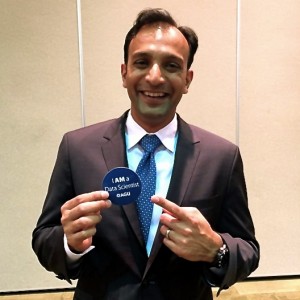22 December 2015
Visualizing Data Science
Posted by lhwang
This is part of a new series of posts that highlight the importance of Earth and space science data and its contributions to society. Posts in this series showcase data facilities and data scientists; explain how Earth and space science data is collected, managed and used; explore what this data tells us about the planet; and delve into the challenges and issues involved in managing and using data. This series is intended to demystify Earth and space science data, and share how this data shapes our understanding of the world.
By Rebecca Fowler

U.S. Chief Data Scientist D.J. Patil at the 2015 AGU Fall Meeting: Proud to be a data scientist. Credit: Kerstin Lehnert
“What is a data scientist?” D.J. Patil, now the U.S. Chief Data Scientist and Deputy Chief Technology Officer for Data Policy, asked an audience of Earth and space scientists during a 14 December American Geophysical Union (AGU) Fall Meeting Town Hall. Many people, even scientists, struggle with this question thanks, in part, to the newness and rapid growth of the field of data science.
Patil coined the term data scientist in 2008 while Chief Data Scientist at LinkedIn. Four years later, in 2012, Harvard Business Review named data scientist the sexiest job of the 21st century. A data scientist is broadly defined as someone with the training, skills and curiosity to make discoveries in the world of big data. Within the fields of Earth and space science, data scientists investigate and address some of the planet’s most complex issues, such as the impacts of climate change.
Patil’s answer to his question: “Everyone here is a data scientist by definition. Everyone here is a scientist and you use data. We’re all data scientists no matter what we call ourselves.”
Earth and space science are in a new mode of operation driven by the massive amounts of complex data made available by modern tools and technologies. Finding relations and patterns in these huge data sets requires new methods of data management and analytics to best extract scientific insights; as a result, the ways that Earth and space scientists work is also changing.
The Town Hall with Patil was the first in a series of four days of data-centric events held at the 2015 AGU Fall Meeting. This “Data Fair” was designed to promote dialogue among those in the scientific community about data science and the issues scientists face when dealing with data. Topics ranged from the challenges data management causes for scientists, to how to maintain the quality and integrity of data over time, and the types of skills and training scientists need to become successful data-wranglers. (View a recording of the Town Hall via AGU On-Demand: http://fallmeeting.agu.org/2015/virtual-options/)
During his hour-long talk, Patil emphasized the ways in which data science benefits from communication. Regardless of whether a person identifies as a data scientist or a geoscientist, everyone in the scientific community has a responsibility to communicate the value of data to science and the pursuit of new knowledge in clear and concise ways. “What we have to do is prove to the world that we can really drive change and we can add value through all the things we do. And we have to step up and communicate that more effectively,” he said.
Patil talked about the use of weather icons in apps as a brilliant way of communicating data science. The icon provides vital information, suggest what action to take and how a person should feel about the weather. For example, a person recognizes what the rain icon with lightning bolts means, and acts accordingly by cancelling her planned golf outing.
In addition to bridging the gap between scientists and the public, Patil stressed the role of communication in creating and nurturing the next generation of data-savvy scientists. Because data science is a new discipline, there are few formal training programs in data science, and the key skills and knowledge needed, including possible academic and career paths, remain largely undefined. As a result, we need more “amazing narrative” and role models like Bill Nye and Neil deGrasse Tyson to expose students to careers in data science and inspire them to pursue such careers. “I think there’s such an amazing opportunity to highlight what cool looks like as a data scientist in oceanography,” Patil said.
Communicating data science in terms people understand, whether to the public, policy makers or students, will ultimately build a broader understanding of the importance of Earth and space science data—and how it’s used to understand our planet.
“We have to make sure that the efforts and energy of what everyone is doing here continues to benefit what is most important of all, which is the scientific understanding of our Earth, our climate and how we interact as a species with our environment,” said Patil.
— Rebecca Fowler is a science communicator and the Director of Communications and Outreach at the Federation of Earth Science Information Partners (ESIP)


 GeoSpace is a blog on Earth and space science, managed by AGU’s Public Information staff. The blog features posts by AGU writers and guest contributors on all sorts of relevant science topics, but with a focus on new research and geo and space sciences-related stories that are currently in the news.
GeoSpace is a blog on Earth and space science, managed by AGU’s Public Information staff. The blog features posts by AGU writers and guest contributors on all sorts of relevant science topics, but with a focus on new research and geo and space sciences-related stories that are currently in the news.